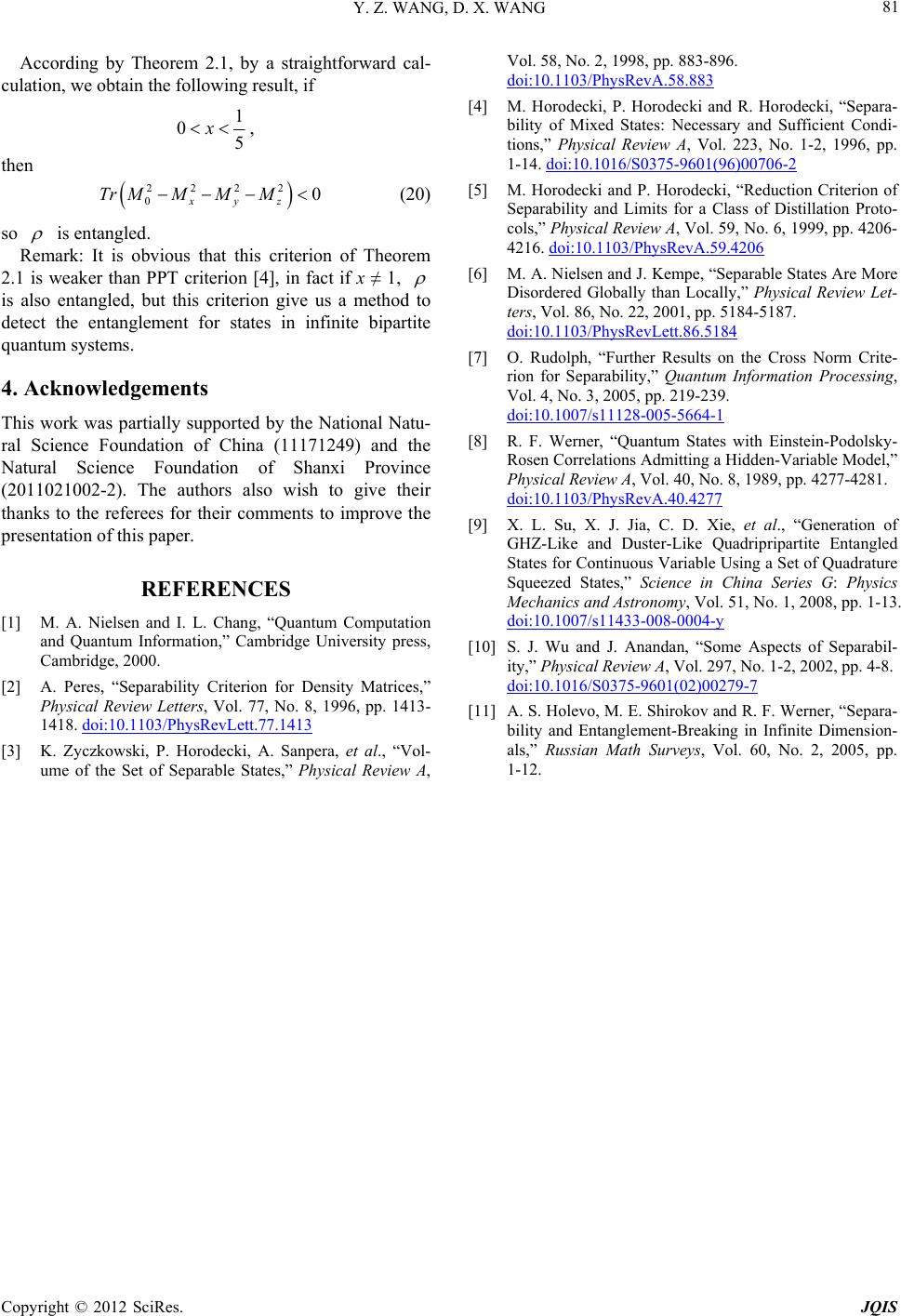
Y. Z. WANG, D. X. WANG
Copyright © 2012 SciRes. JQIS
81
According by Theorem 2.1, by a straightforward cal-
culation, we obtain the following result, if
1
05
x,
then
2222
00
xyz
TrMMMM (20)
so
is entangled.
Remark: It is obvious that this criterion of Theorem
2.1 is weaker than PPT criterion [4], in fact if x ≠ 1,
is also entangled, but this criterion give us a method to
detect the entanglement for states in infinite bipartite
quantum systems.
4. Acknowledgements
This work was partially supported by the National Natu-
ral Science Foundation of China (11171249) and the
Natural Science Foundation of Shanxi Province
(2011021002-2). The authors also wish to give their
thanks to the referees for their comments to improve the
presentation of this paper.
REFERENCES
[1] M. A. Nielsen and I. L. Chang, “Quantum Computation
and Quantum Information,” Cambridge University press,
Cambridge, 2000.
[2] A. Peres, “Separability Criterion for Density Matrices,”
Physical Review Letters, Vol. 77, No. 8, 1996, pp. 1413-
1418. doi:10.1103/PhysRevLett.77.1413
[3] K. Zyczkowski, P. Horodecki, A. Sanpera, et al., “Vol-
ume of the Set of Separable States,” Physical Review A,
Vol. 58, No. 2, 1998, pp. 883-896.
doi:10.1103/PhysRevA.58.883
[4] M. Horodecki, P. Horodecki and R. Horodecki, “Separa-
bility of Mixed States: Necessary and Sufficient Condi-
tions,” Physical Review A, Vol. 223, No. 1-2, 1996, pp.
1-14. doi:10.1016/S0375-9601(96)00706-2
[5] M. Horodecki and P. Horodecki, “Reduction Criterion of
Separability and Limits for a Class of Distillation Proto-
cols,” Physical Review A, Vol. 59, No. 6, 1999, pp. 4206-
4216. doi:10.1103/PhysRevA.59.4206
[6] M. A. Nielsen and J. Kempe, “Separable States Are More
Disordered Globally than Locally,” Physical Review Let-
ters, Vol. 86, No. 22, 2001, pp. 5184-5187.
doi:10.1103/PhysRevLett.86.5184
[7] O. Rudolph, “Further Results on the Cross Norm Crite-
rion for Separability,” Quantum Information Processing,
Vol. 4, No. 3, 2005, pp. 219-239.
doi:10.1007/s11128-005-5664-1
[8] R. F. Werner, “Quantum States with Einstein-Podolsky-
Rosen Correlations Admitting a Hidden-Variable Model,”
Physical Review A, Vol. 40, No. 8, 1989, pp. 4277-4281.
doi:10.1103/PhysRevA.40.4277
[9] X. L. Su, X. J. Jia, C. D. Xie, et al., “Generation of
GHZ-Like and Duster-Like Quadripripartite Entangled
States for Continuous Variable Using a Set of Quadrature
Squeezed States,” Science in China Series G: Physics
Mechanics and Astronomy, Vol. 51, No. 1, 2008, pp. 1-13.
doi:10.1007/s11433-008-0004-y
[10] S. J. Wu and J. Anandan, “Some Aspects of Separabil-
ity,” Physical Review A, Vol. 297, No. 1-2, 2002, pp. 4-8.
doi:10.1016/S0375-9601(02)00279-7
[11] A. S. Holevo, M. E. Shirokov and R. F. Werner, “Separa-
bility and Entanglement-Breaking in Infinite Dimension-
als,” Russian Math Surveys, Vol. 60, No. 2, 2005, pp.
1-12.